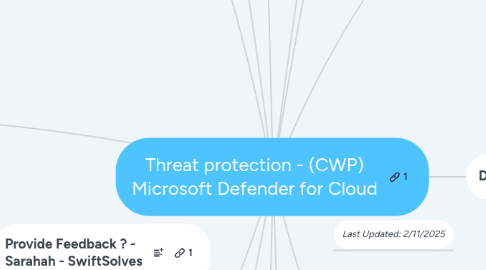
1. Defender for SQL (PaaS\IaaS\On-Prem)
1.1. SQL Injection
1.2. Suspicious Logins
1.3. SQL Brute Force
1.4. High priv SQL commands
1.5. Unusual Export location
1.6. vulnerability assessment
1.6.1. permission configurations
1.6.2. feature configurations
1.6.3. database settings
2. Azure PaaS
2.1. Azure Storage
2.1.1. Malware Hash Reputation Analysis
2.1.2. Phishing campaigns, unusual access
2.1.3. NRT Malware Scanning
2.2. Azure Cosmos Database
2.2.1. Potential SQL injection
2.2.2. Anomalous database access patterns
2.2.3. Suspicious database activity
2.3. Azure KeyVault
2.4. Azure Resource Manager - Management APIs
2.5. Azure App Service
2.6. Azure Database for Open Source relational databases
2.6.1. PostgreSQL
2.6.2. MySQL
2.6.3. MariaDB
3. Defender for Containers
3.1. Architecture
3.2. Kubernetes (AKS, EKS, K8S via ARC) (cluster)
3.2.1. Gate Keeper - Policy Control
3.2.2. Runtime Vulnerability assessments (AKS)
3.2.3. creation of high privileged roles
3.2.4. abnormal service account operation and abnormal managed identity association
3.2.5. creation of sensitive mounts
3.2.6. Excessive role permissions assigned in Kubernetes cluster
3.2.7. Anomalous pod deployment
3.2.8. exposed K8s dashboards
3.3. Host level (node) Daemon set
3.3.1. web shell detection
3.3.2. Suspicious Logins
3.3.3. Privileged container creation
3.3.4. SSH Server hosted in container
3.3.5. suspicious access to API
3.3.6. Exposed Docker API \ Services
3.4. Azure Container Registry
3.4.1. Vulnerability management
4. Security Analytics
4.1. Integrated threat intelligence
4.1.1. Microsoft Threat Intelligence Center (MSTIC)
4.1.1.1. Outbound communication to a malicious IP address
4.1.2. Digital Crimes Unit
4.1.3. 3rd Party Lists
4.1.4. Cloud Service Provider sharing
4.1.5. Instruments
4.1.5.1. Sample Zoos
4.1.5.2. Original research
4.1.5.3. Dark markets
4.1.5.4. Threat feeds
4.1.5.5. Sinkholes & Honeypots
4.1.5.6. Detonation & sandboxes
4.1.5.7. Customer IR intelligence
4.2. Behavioral analytics
4.2.1. Suspicious process execution
4.2.2. Hidden malware and exploitation attempts
4.2.3. Lateral movement and internal reconnaissance
4.2.4. Malicious PowerShell Scripts
4.2.5. Outgoing attacks
4.3. Anomaly detection
4.3.1. Inbound RDP/SSH Brute force attacks
4.3.2. Bloom Filtering Multivariate
5. Defender for IoT
6. Defender for DevOps
6.1. Discover misconfigurations in Infrastructure as Code (IAC)
6.2. MSDO command line
6.2.1. Bandit
6.2.2. BinSkim
6.2.3. ESLint
6.2.4. TemplateAnalyzer
6.2.5. Terrascan
6.2.6. Trivy
6.2.7. Antimalware
7. Defender for APIs
7.1. Integrate with Azure API Management Service & Monitor API traffic to detect threats
7.1.1. Spike in API Activity including traffic, payloads, and unusal large requests
7.1.2. API parameter enumeration & manipulation
7.1.3. API Spray Requests
7.1.4. OWASP API Top 10 - Threat Detection
7.1.5. Scanning data and tag API for Sensitive Data passed
8. Windows
8.1. Crash dump analysis
8.1.1. Shell code discovered
8.1.2. Code injection discovered
8.1.3. Masquerading Windows Module Detected
8.2. Fileless attack
8.2.1. memory process contains attack toolkit
8.2.2. shell code
8.3. Microsoft Defender for Endpoint
8.3.1. PowerShell scripts
8.3.2. Fileless malware
8.3.3. Credential dumping
8.4. Event ID 4688 - A new process has been created
8.5. SQL Brute Force
8.6. Cypto mining attack
8.7. Integrated vulnerability assessment solution for Azure and hybrid machines
9. Linux
9.1. AuditD
9.2. crypto mining campaign
9.3. bash scripts
9.4. password spray
9.5. Microsoft Defender for Endpoint: Linux
9.5.1. EDR for Linux
9.5.2. Behavior monitoring and blocking
9.5.3. AntiVirus Solution
9.6. Fileless Attack
9.7. Integrated vulnerability assessment solution for Azure and hybrid machines
10. Kill chain intents
10.1. PreAttack
10.2. IntialAccess
10.3. Persistence
10.4. PrivilegeEscalation
10.5. DefensiveEvasion
10.6. CredentialAccess
10.7. Discovery
10.8. LateralMovement
10.9. Execution
10.10. Collection
10.11. Exfiltration
10.12. CommandAndControl
10.13. Impact
11. 474 Unique Detections
12. Test Drive Microsoft Defender for Cloud
12.1. Simulations
13. Last Updated: 1/9/2024
14. Provide Feedback ? - Sarahah - SwiftSolves
15. Defender for Servers P2
15.1. Adaptive Application Controls
15.2. File Integrity Monitoring
15.3. Azure Network Layer
15.4. VM Extension Detections
15.4.1. Sudden surge in extension usage by a suspicious account
15.4.2. Code or script execution containing parts indicating malicious intent
15.4.3. Combination of extensions indicating a recon attempt
15.4.4. Suspicious installation of disk nncryption
15.5. DNS
15.5.1. Data exfiltration from your Azure resources using DNS tunneling
15.5.2. Malware communicating with C&C server
15.5.3. Communication with malicious domains as phishing and crypto mining
15.5.4. DNS attacks - communication with malicious DNS resolvers
